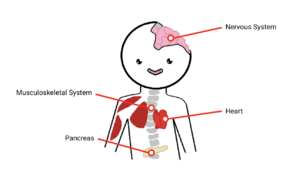Course:MEDG550/Student Activities/Friedreich's ataxia
Friedreich's ataxia (also referred to as FRDA or FA) is an inherited (genetic) disease affecting muscle control.[1] There is a slow and continual loss of neurons (nerve cells) found in the brain and the nervous system. This gradual loss of neurons (ataxia) in people with FRDA commonly begins in childhood.[1] They generally have trouble walking, talking, and moving arms and legs.[1]
Symptoms
Most people with FRDA will begin to show symptoms between the ages of 10 to 16.[2] Though some people may have symptoms earlier or later in life.[1]

FRDA can affect many parts of the body:[2]
- Nervous system
- Musculoskeletal system
- Heart
- Pancreas
Common Symptoms
People with FRDA experience ataxia where they have trouble moving their muscles.[1] Their muscles may be difficult to control.[1] They have trouble with walking, moving, and talking.[1] These symptoms can worsen over time. Common symptoms include:[1][2]
- Poor muscle control in arms and legs
- Difficulty with walking
- Eventual loss of walking
- Slurred speech and trouble with swallowing (Dysarthria)
- Absent reflex in legs
- Curved spine (Scoliosis)
Additional Symptoms
People with FRDA may develop these additional symptoms later in life:[2][3]
- Diabetes Mellitus
- Thickened heart muscles (Hypertrophic cardiomyopathy)
- Hearing loss
- Vision loss

Prevalence
FRDA affects about 1 in 40 000 people and it is the most common form of hereditary ataxia in the following regions:[1]
- (South-West, North, East) Europe[2]
- Middle East
- South Asian
- North African
Genetics

Our body has genetic information that makes us unique and helps us grow.[4] This genetic information is stored in our DNA (deoxyribonucleotide acid) which is made up of a string of nucleotides (A, T, C, or G).[5] In our body's cells, our DNA is packaged into structures called chromosomes.[6] Each of our cells should have 46 chromosomes (or 23 pairs).[7] Half of our chromosomes come from our mom and the other half comes from our dad.
Our chromosomes carry more than 20 000 different genes[4]. Genes can be thought of like recipes in a cookbook, where our DNA spells out the instructions to make the food. In this case, our genes are responsible for making protein which are like building blocks in our body. We need proteins to build the different parts of our body like muscles, bone, teeth, and more.[4]
DNA is not always perfect. We have mutations (changes) in our genes that differ from other humans. On occasion, these mutations are harmless and do not affect our proteins. But sometimes these gene mutations can affect the protein production. We could potentially have little to none protein made.
These gene mutations can be passed on from parent to child. Depending on the inherited mutation, it can cause genetic disease.
FXN Gene
Friedreich's ataxia is caused by a mutation (change) in the FXN gene.[2] The FXN gene has the instructions to make frataxin protein that is important for our mitochondria to work properly.[2] Mitochondria are tiny structures found in our cells and they produce energy. Mitochondria is sometimes referred to as the powerhouse of the cell. Lots of mitochondria are found in the cells of our organs that need a lot of energy like our brain, heart, and nervous system.
If there is a mutation in the FXN gene, the gene cannot work properly. If FXN gene does not work properly, there will not be enough frataxin protein made.[2] With a decrease in frataxin protein, our mitochondria cannot make enough energy. Without enough energy, our cells will die.[2] Our organs that need lots of mitochondria to make energy will be affected. This is why individuals with FRDA experience symptoms that affect their nervous system, muscles, and heart.[2]
Trinucleotide Repeat
Approximately 98% of people with FRDA have a specific mutation called a trinucleotide repeat expansion.[8] A trinucleotide repeat is when there is a group of 3 nucleotides repeated within a sequence. In this case, the nucleotides GAA is the repeated pattern within the FXN gene.[2] If a trinucleotide repeat is repeated many times, it is called an expansion. However, if the trinucleotide repeat of GAA is repeated too many times within FXN gene, it can reduce the amount of frataxin protein produced.[2]
There is a normal and abnormal range of trinucleotide repeats for FRDA:[8]
- 6 to 34 GAA repeats in FXN gene is normal
- Normal amounts of frataxin protein will be made
- 67 to 1700 GAA repeats in FXN gene is an abnormal change (mutation) that will affect the gene
- There will be a reduced amount of frataxin protein made
Other Mutations
Point mutations and deletions make up the other 2% of mutations found in the FXN gene that can lead to FRDA.[8] Point mutations occur when a single nucleotide (A, T, C, or G) changes to a different nucleotide. Deletions occur when one or more nucleotides are removed from the sequence of DNA.

Inheritance
For every gene we have, we inherit one copy from our mom and one copy from our dad. Diseases or traits are inherited in either a dominant or recessive pattern. If a disease involves a dominant gene, you only need one gene with the mutation (change) to be affected by the disease. If a disease involves a recessive gene, this means you need two genes with the mutation to be affected by the disease.
Friedreich's ataxia is inherited in an autosomal recessive pattern.[2] This means two FXN genes with the abnormal mutation must be inherited to develop FRDA.
If someone has one mutated FXN gene and one normal FXN gene, then they are a carrier.[2] Carriers are healthy and are not affected by the disease.[2] Carriers will have a 50% chance of passing on their normal FXN gene and a 50% chance of passing on their mutated FXN gene to their child.
If both parents are carriers of a mutated FXN gene, they may expect these potential outcomes for each pregnancy:
- A 25% chance of having a child that is not affected
- A 50% chance of having a child that is a carrier
- A 25% chance of having a child that is affected
Diagnosis
If someone is suspicious for having FRDA, their symptoms should be examined by their healthcare provider.[3] Their provider will collect medical history and do a physical exam.[3] Providers will look for symptoms such as:[3]
- Difficulty with walking and balancing
- Loss of reflex in their arms and legs
Their provider may refer them to have other tests done (through neurology or cardiology) to help with the diagnosis.[3] These extra tests can check the parts of the body (like the brain and heart) that may be affected by FRDA.[3]
Genetic testing is offered to confirm the diagnosis of FRDA and can report the number of trinucleotide repeats they have.[3]Genetic testing can help identify who might carry the mutation.
Prognosis
The progression and worsening of symptoms will vary between people with FRDA.[3] Individuals can expect to lose their ability to walk within 10 to 20 years after onset of first symptoms.[3] The average age of death is 36.5 years with cardiomyopathy (disease of the heart) as the most common cause.[9] Though there may be a shorter lifespan, people with milder symptoms may live well into their 60s-70s.[3]
Management
There is no cure or treatment that can stop the progression of FRDA.[3] Management focuses on treating the symptoms to help maintain their quality of life.[2] Since many parts of the body are affected, staying connected to a healthcare team will be important to address their needs.
Patients with FRDA will benefit from therapy:[2]
- Physiotherapy can help them improve their muscle control and strength
- Occupational therapy can help them improve their ability to perform tasks independently
- Speech-language therapy can help patients who have trouble swallowing or speaking
Regular visits to specialized healthcare professionals will be important for monitoring their health:[2]
- Neurology to examine brain and nervous system
- Cardiology to examine their heart
- Ophthalmology to examine their eyes
- Urology to help treat their diabetes mellitus
- Psychiatry to help treat changes in their mood
- Orthopedics to treat their muscle and bone pain
Genetic Counselling
A genetic counsellor is trained in both genetics and counselling. They speak to patients and families with genetic diseases like FRDA. During an appointment, GCs gather personal and family medical information. Using this information, GCs identify who in the family might be at risk of having the disease. They also identify family members who qualify for genetic testing and counselling. GCs educate patients on how their own genetics can cause the disease. Patients can gain an understanding of how their disease will impact their life.
Patients and families with genetic diseases will have important decisions to make. They might have questions like:
- How do I tell my family members that they might be at risk of having the disease?
- Should I have genetic testing done even though I don't have symptoms yet?
- Can I still have children in the future?
GCs provide emotional support to patients as they learn more about their disease. GCs can also help at-risk patients who carry the genetic cause of the disease by:
- Arranging genetic testing as needed
- Identify carriers in the family
- Offering genetic counselling to carrier couples who want to start a family
Patient Resources
While FRDA is a rare genetic disease, you are not alone. Here are some resources from patients living with FRDA:
Websites
Friedreich's Ataxia Parents' Group
Friedreich's Ataxia Research Alliance
Podcasts
My Rare Disease: Friedreich's ataxia - Georgia Hart
Once Upon a Gene ep 45: Two Disabled Dudes - Kyle Bryant and Sean Baumstark
References
- ↑ 1.0 1.1 1.2 1.3 1.4 1.5 1.6 1.7 1.8 National Organization for Rare Disorders. (2018, February 15). Friedreich's Ataxia. https://rarediseases.org/rare-diseases/friedreichs-ataxia/
- ↑ 2.00 2.01 2.02 2.03 2.04 2.05 2.06 2.07 2.08 2.09 2.10 2.11 2.12 2.13 2.14 2.15 2.16 2.17 Cook, A., & Giunti, P. (2017). Friedreich's ataxia: clinical features, pathogenesis and management. British medical bulletin, 124(1), 19–30. https://doi.org/10.1093/bmb/ldx034
- ↑ 3.00 3.01 3.02 3.03 3.04 3.05 3.06 3.07 3.08 3.09 3.10 National Institute of Neurological Disorders and Strokes. (2022, July 25). Friedreich Ataxia Fact Sheet. https://www.ninds.nih.gov/friedreich-ataxia-fact-sheet
- ↑ 4.0 4.1 4.2 Medline Plus. (2021, March 22). What is a gene? https://medlineplus.gov/genetics/understanding/basics/gene/
- ↑ Medline Plus. (2021, January 19). What is DNA? https://medlineplus.gov/genetics/understanding/basics/dna/
- ↑ Medline Plus. (2021, January 19). What is a chromosome? https://medlineplus.gov/genetics/understanding/basics/chromosome/
- ↑ Medline Plus. (2021, June 1). How many chromosomes do people have?https://medlineplus.gov/genetics/understanding/basics/howmanychromosomes/
- ↑ 8.0 8.1 8.2 Firth, H.V., & Hurst, J.A. (2017). Oxford Desk Reference: Clinical Genetics & Genomics (pp. 75). Oxford, Oxford University Press.
- ↑ Tsou, A. Y., Paulsen, E. K., Lagedrost, S. J., Perlman, S. L., Mathews, K. D., Wilmot, G. R., ... & Lynch, D. R. (2011). Mortality in Friedreich ataxia. Journal of the neurological sciences, 307(1-2), 46-49.
| Guidelines | Create Your Wiki Page | Past Projects | Help and Resources |
 | |
|---|---|
| Course title | |
| Instructor: | |
| Email: | |
| Office: | |
| Office Hours: | |
| Class Schedule: | |
| Important Course Pages | |
Add a content here. You can also copy and paste content for each tabs from below: